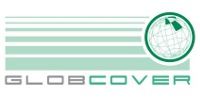GlobCover

Building on the success of the GLC-2000 project (Global Land Cover map for the year 2000) coordinated by the JRC, ESA decided to launch the GlobCover initiative in the framework of its Data User Element (DUE). The European Space Agency's two-year GlobCover project has developed a service capable of delivering land cover maps on the basis of satellite images, thanks to observations from the 300m MERIS (MEdium Resolution Imaging Spectrometer) sensor on board the ENVISAT ("Environmental Satellite") mission. Many scientists used the previous GlobCover map for various studies, such as on land cover or biofuels. The map proved extremely relevant for further environmental and sustainability related studies, in particular in relation to the classification and validation of global land cover.
In 2008, the ESA-GlobCover 2005 project delivered its first product: the very first 300m resolution global land cover map for 2005 together with bimonthly and annual MERIS1 Full Resolution Full Swath (FRS) surface reflectance mosaics. This project, carried out by an international consortium, started in April 2005 and relied on very rich feedback and comments from a larger partnership including end users belonging to international institutions. The European Commission's Joint Research Centre (JRC) was involved in the validation of the first GlobCover product. The ESA-GlobCover 2005 deliverables clearly demonstrated the possibility to develop an automated service, from the technical level imagery to the final land cover map, including all the pre-processing steps and the classification process.
In 2010, the GlobCover chain was run by the European Space Agency (ESA) and the Catholic University of Louvain (Université Catholique de Louvain) in order to produce bimonthly and annual MERIS1 FRS2 mosaics for the year 2009 and to derive a new global land cover map from this time series of MERIS FRS 2009 mosaics. This objective of rendering the full set of GlobCover 2009 deliverables useful for science has now been achieved; the results demonstrate the operational services provided by the developed GlobCover chain.
An international network of partners that worked with ESA on the GlobCover project include the United Nations Environment Programme (UNEP), the Food and Agriculture Organisation (FAO), the European Commission's Joint Research Centre (JRC), the International Geosphere-Biosphere Programme (IGBP) and the Global Observations of Forest Cover and Global Observations of Land Dynamics (GOFC-GOLD) Implementation Team Project Office.